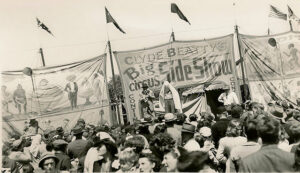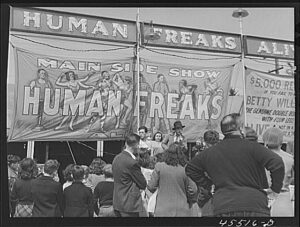Two of the most terrifying killers of the nineteenth century seem nearly innocuous at first glance. Mary Ann Cotton was a British woman, the frail-looking daughter of a coal miner (Wilson and Frey). She worked as a dressmaker, nurse, and housekeeper and insisted on looking after sick relatives (Wilson and Frey). Belle Gunness was a hard-working Norwegian immigrant to America who took in three foster children (Greig). Both were charming and married more than once. For both women, when their crimes first came to light, the response was disbelief (Mayo 138, and Wilson and Frey). After all, how could a wife and a mother kill anyone?
Serial killers enthrall the collective American imagination (Schurman-Kauflin 6). From horror movies’ constant stream of ax murderers and psychopaths to real-life killers like Jack the Ripper and Charles Manson, Western culture can’t let go of the idea of the undetected, repeat killer in the shadows. Because of the public’s desire for sensational and increasingly grotesque true crime stories, serial killers make ideal media icons (14). Nearly all of these nightmarish figures, however, are men. Still, even during the 1800s, female killers like the black widow Mary Ann Cotton and the Lady Bluebeard Belle Gunness did exist and killed dozens of people.
Society has trouble accepting the possibility of female mass killers (Schurman-Kauflin 13). As Elizabeth and Harold Schechter of Queens College write, the image of a woman as a serial killer is “commonly denied, or merely ignored, as something of a conceptual impossibility” (qtd. in Wilson and Yardley 22). The Western cultural role of women as fragile, nurturing, and submissive does not square with the brutal actions of serial killers, so many members of the public and academia do not ponder the existence of female serial killers. As David Schmid writes in his book Natural Born Celebrities: Serial Killers in American Culture, “[t]he serial killer both outrages and thrills us by his seeming ability to stand outside the law, to make his own law, in a gesture whose  ambivalent destructiveness and creativity mirror our ambivalent response to the killer, composed of both fear and attraction” (24). In a perverse way, the serial killer reflects America’s cultural narrative about men. He is fiercely independent, and has the freedom to “make his own law”—to live completely on his own terms and cleverly and creatively achieve his goals. The terrifying nature of these goals repels the public, and the media’s framing of these acts as those of nearly supernatural levels of evil helps define the killer outside of the mainstream (Schmid 7). Still, as Jeffrey Jerome Cohen, professor of English at George Washington University, states, “the linking of monstrosity with the forbidden makes the monster all the more appealing as a temporary egress from constraint” (qtd. in Schmid 8). The serial killer’s monstrosity demonstrates a way to break with norms and expectations in a way that inspires as much as it terrifies.
ambivalent destructiveness and creativity mirror our ambivalent response to the killer, composed of both fear and attraction” (24). In a perverse way, the serial killer reflects America’s cultural narrative about men. He is fiercely independent, and has the freedom to “make his own law”—to live completely on his own terms and cleverly and creatively achieve his goals. The terrifying nature of these goals repels the public, and the media’s framing of these acts as those of nearly supernatural levels of evil helps define the killer outside of the mainstream (Schmid 7). Still, as Jeffrey Jerome Cohen, professor of English at George Washington University, states, “the linking of monstrosity with the forbidden makes the monster all the more appealing as a temporary egress from constraint” (qtd. in Schmid 8). The serial killer’s monstrosity demonstrates a way to break with norms and expectations in a way that inspires as much as it terrifies.
Female killers do not represent this same level of fear and admiration (Wilson and Yardley 22). The nicknames assigned to female serial killers often seem comical in comparison to their male counterparts (22). The mental image of a “Lady Bluebeard” or “Black Widow” does not pack the same visceral and linguistic punch of a title like “Jack the Ripper” or the “Boston Strangler” (22).The basis for the difference in views of male and female serial killers is complex. A combination of the lack of information and data on these women, the often less sensational circumstances of their crimes, and the societal and cultural views of women mean that these women are often not analyzed to the same extent as male killers.
On the surface, this difference may simply distill down to numbers. Over 90 percent of serial killers are white men (Berry-Dee xiii). Throughout the 1980s and 1990s, women still made up only 10-13 percent of all murderers (Hale and Bolin 36-37). Female serial killings have, however, recently risen at an alarming rate (Schurman-Kauflin 12). Almost a third of all known female serial killers began killing since the 1970s (12). This extreme increase is troubling and threatening, though all but ignored in popular media (12). While part of the discrepancy can be accounted for by the fact that the number of female serial killers is still relatively low, other factors may also be at play in this lack of visibility (14).
The less sensational circumstances of female serial killers’ crimes also make them less likely to be thought about and analyzed at the same level as men. Female multiple murderers tend to kill their victims in less noticeable ways than men, for example, poisoning, allowing them to operate longer than their male counterparts; on average, they kill for 4.2 more years (Schurman-Kauflin 15). As many as two-thirds of victims of female serial killers are close to the murderers; these victims may be children, spouses, or sexual partners (Hale and Bolin 45). Most female serial killers also attack already powerless groups of “latent victims,” like the elderly, children, or sick people (38,42). A murderer who kills people she knows cannot fight back via subtle means does not feel as threatening as a killer who mutilates strangers, which may be why female killers are less academically studied and known by the public.
In addition, female serial killers may be less common and less vicious toward their victims for cultural reasons (Hale and Bolin 34). Due to societal gender roles, boys are rewarded for being aggressive and using this aggression to control and reinforce interpersonal relationships (34). Girls are not (34). Very few studies suggest any actual biological difference that underlies this difference in aggression (Hale and Bolin 35). Though some suggest that hormones may play a role in determining behavior, none shows that hormones completely explain the difference (35-36). While women are generally less violent than men, they also tend to be more aware of the consequences of their actions (34). This fear of retribution may be the reason that so few women kill multiple people and why they use subtler methods to kill. Women also are less likely to talk about and discuss their crimes, which makes gathering data via personal interviews difficult (Schurman-Kauflin 14). Because of these cultural roles and lack of visibility, many have trouble imagining women as serial killers (13).
The way that serial killers are analyzed, categorized, and thought about academically is often messy and nearly entirely male-centric, which makes analyzing female serial killers within this framework difficult. First, the definition of “serial killer” is not rigid and may leave out female multiple killers (Schurman-Kauflin 7). Some definitions emphasize the number of victims, with the requisite number of victims ranging from as few as two to as many as ten (7). Others stress time (7). One of the most commonly agreed-upon definitions includes three separate killings over a period of 30 or more days with a period of “cooling off” in between each murder, a definition that both Mary Ann and Belle fit (Holmes and Holmes, 1). Other definitions, however, insist that the killer’s state of mind is more important, stressing sexuality or power and domination (Schurman-Kauflin 7-8). The sexual components of many serial killers’ crimes may be simply an extension of the killer’s desire to exert control over victims (15).
The way that serial killers are analyzed, categorized, and thought about academically is often messy and nearly entirely male-centric, which makes analyzing female serial killers within this framework difficult.
Whatever definition the researcher decides to use for a serial killer, a key focus of the research is usually to find common characteristics among killers in order to better understand the murderers and predict other serial killers’ behavior (Schurman-Kauflin 11). By studying behavior and psychology, law enforcement can construct profiles to catch multiple murderers (11). Research tends to focus on male killers (12). Several researchers, however, have developed categories or typologies specifically for female killers (155). For example, Holmes and Holmes propose five different categories of female multiple killers: visionary, comfort, hedonistic, power/control and disciple (155). While most multiple murderers are sane and not psychotic at the time of their crimes, the visionary has a break with reality and feels compelled to kill (Holmes, Hickey and Holmes 65). The comfort killer, the most common kind of female serial killer, wants material gain (66). The hedonistic type is a woman who connects murder and pleasure (67). A power-seeking killer wants to exert domination over another person (67). Finally, the disciple follows a cult-leader to kill (68). These typologies can help make sense of serial killers like Mary Ann Cotton and Belle Gunness.
The details of Mary Ann Cotton’s life can vary greatly from source to source. By synthesizing these sources, however, the story of Mary Ann’s life comes into focus. Mary Ann was born as Mary Ann Robson, daughter of Margaret and Michael Robson in County Durham, England, in 1832 (Wilson and Yardley 23). At age 20, she married William Mowbray (Hale and Bolin 46). The two remained married for twelve years, until William died in 1865, and during this marriage, the two had several children, all but two of whom died before Mowbray himself (Wilson and Frey). Mary Ann cashed in a life insurance policy on Mowbray for around 35 pounds (Wilson and Yardley 23). One of the remaining children died soon after, and Isabella, the last surviving child, moved in with Mary Ann’s mother (Hale and Bolin 47). Mary Ann continued this pattern with several men: one patient at a hospital where Mary Ann worked, and two widowers with children (Wilson and Yardley 24). Her husbands, her children, and her stepchildren all continued to die (24). Isabella and Mary Ann’s mother also died under her care (24). Mary Ann’s last marriage was to Frederick Cotton, the source of the surname by which she is most often known (Wilson and Frey). Frederick and his children met the same fate as Mary Ann’s other family members (Wilson and Frey). After Mary Ann sought to put the last surviving child of Frederick’s in the workhouse, the director of poor relief for the area, Thomas Riley, became suspicious (24). She reported that she found the child, Charles Edward, burdensome, and, furthermore, he was an obstacle to her possible engagement to another man (Wilson and Frey). She even told Riley, in front of the child, that Charles Edward would soon go like the rest of her children (Wilson and Frey). Riley refused to put the child in the harsh conditions of the workhouse unless Mary Ann went with him, which she refused (Wilson and Frey). Soon after, the child died, and a local doctor found he had been poisoned by arsenic (25). Mary Ann was hung for the boy’s murder in 1873 (Wilson and Frey). In the end, Mary Ann was suspected of killing as many as twenty people (Wilson and Frey).
Deborah Blum, author of The Poisoner’s Handbook, writes that Mary Ann’s choice of arsenic may be a strong reason that Mary Ann has not gained as much notoriety as other serial killers (Wilson and Frey). Arsenic was a common murder weapon, accounting for about 40% of all poisonings in Europe at the time, for two main reasons (Wilson and Frey). It was used in many everyday  products, such as wallpaper and rat poison (Wilson and Frey). A friend of Mary Ann’s testified that she had helped Cotton use arsenic to treat a bed bug infestation (Wilson and Frey). Arsenic was also almost impossible to detect; Rudolph Witthaus, a forensic chemist, found that less than 2% of survivors of arsenic poisoning could taste the poison while being poisoned (Wilson and Frey). Even doctors could not be sure when they saw arsenic poisoning; the terms “gastric fever” or “diarrhea” on Mary Ann’s victims’ death certificates may indicate that the physicians were unsure of the cause of death (Hale and Bolin 48). Because of the poison’s ubiquity and subtlety, arsenic poisoners even with many victims were simply not as sensational as more violent murderers.
products, such as wallpaper and rat poison (Wilson and Frey). A friend of Mary Ann’s testified that she had helped Cotton use arsenic to treat a bed bug infestation (Wilson and Frey). Arsenic was also almost impossible to detect; Rudolph Witthaus, a forensic chemist, found that less than 2% of survivors of arsenic poisoning could taste the poison while being poisoned (Wilson and Frey). Even doctors could not be sure when they saw arsenic poisoning; the terms “gastric fever” or “diarrhea” on Mary Ann’s victims’ death certificates may indicate that the physicians were unsure of the cause of death (Hale and Bolin 48). Because of the poison’s ubiquity and subtlety, arsenic poisoners even with many victims were simply not as sensational as more violent murderers.
Belle Gunness was born in 1859 in Norway, as Brynhild Paulsdatter Storset, and emigrated to the United States. She married twice, both to fellow immigrants. She lived in Chicago with her first husband, Mads Sorenson, and the couple fostered three children. Mads reportedly died of “heart failure,” but showed the symptoms of strychnine poisoning. Belle claimed $8,500 in life insurance and moved to a farm in La Porte, Indiana, with her foster daughters. Belle then married a fellow Norwegian immigrant, Paul Gunness, though he died three years later. Allegedly, a sausage grinder fell on his head, although the wound resembled a hammer’s impact, an act that a strongly built 280-pound woman like Belle could easily have committed. She received another $4,000 in life insurance. She then posted ads in Norwegian language newspapers advertising herself as a wealthy widow searching for a husband. Some men came to La Porte to answer the ad, but disappeared soon after arriving (Mayo 138). One of the foster children and some of Belle’s farm’s employees disappeared too (Greig). On April 28, 1908, a fire broke out on the farm (Greig). After the blaze, three bodies were found (Greig). Two were identified as Belle’s daughters, and the other was the beheaded body of an adult woman (Greig). Because the body was decapitated, authorities could not immediately identify it, though they suspected it was Belle’s (Greig). Still, Belle was tall, and the body seemed too short to be hers (Mayo 138). Though later recovered dental evidence identified the corpse as Belle’s, rumors persisted that Belle had survived the fire, and neighbors even reported spotting her (Mayo 139). A farmworker named Ray Lamphere was convicted for setting the fire and killing the Gunness women, but Lamphere continued to protest that Belle had survived (Mayo 139). Upon further investigation of the burned farmhouse, investigators found fourteen corpses in the fire’s rubble: the missing daughter, Jennie; two workers; five of Belle’s suitors, and six unidentified bodies, assumed to be more suitors (Greig). Belle had killed over a dozen people and may have escaped retribution (Greig).
Both Mary Ann’s and Belle’s murders could be classified as either comfort killings or power-seeking murders by the Holmes’ definition. Since these women’s husbands often had life insurance, each may have seen the killings as a way to financially better herself. They may also have sought to rid themselves of the financial and emotional burden of children. In Mary Ann’s case, however, the deaths of the uninsured children may indicate that Mary Ann enjoyed exerting power over others, to the point of death. According to David Wilson and Elizabeth Yardley’s analysis, Mary Ann scored at the high end of the revised psychopathy checklist, which defines her as a psychopath (Wilson and Yardley 26). This score may even be an underestimate (26). No matter whether she was clinically a psychopath, Mary Ann did not value human life, nor did she object to taking it. Similarly, the fact that Belle lured men to her farm and then killed them does not seem to indicate solely a desire for profit. These circumstances seem frighteningly similar to male serial killers who also lure and kill. Belle may have sought to assert power over men with a violent weapon like the hammer she used in Sorenson’s death. While examining these women through the lens of a typology is useful, researchers will probably never be certain what motivated these nineteenth-century women to kill over and over because of fading memories of the past. Still, they continue to search for answers.
Bibliography
Berry-Dee, Christopher. Serial Killers: Up Close and Personal- Inside the World of Torturers, Psychopaths and Mass Murderers. Berkeley: Ulysses, 2007. Print.
Greig, Charlotte. Evil Serial Killers: In the Minds of Monsters. London: Arcturus, 2005. Print.
Hale, Robert and Anthony Bolin. “The Female Serial Killer.” In Contemporary Perspectives on Serial Murder. Ronald M.Holmes and Stephen T. Holmes, Eds. Thousand Oaks, CA: Sage, 1998: 33-59. Print.
Holmes, Stephen M., Eric Hickey and Ronald M. Holmes. “Female Serial Murderesses: The Unnoticed Terror.” In Contemporary Perspectives on Serial Murder. Ronald M. Holmes and Stephen T. Holmes, Eds. Thousand Oaks, CA: SAGE, 1998: 59-71. Print.
Holmes, Ronald M. and Holmes, Stephen T., eds. Contemporary Perspectives on Serial Murder. 1st ed. Thousand Oaks: SAGE, 1998. Print.
Mayo, Mike. American Murder: Criminals, Crime and the Media. Canton: Visible Ink, 2008. Print.
Schmid, David. Natural Born Celebrities: Serial Killers in American Culture. Chicago: University of Chicago Press, 2005. Print.
Schurman-Kauflin, Deborah. New Predator: Profiles of Female Serial Killers. New York: Algora, 2000. Print.
Wilson, David and Elizabeth Yardley. “The Psychopathy of a Victorian Serial Killer: Integrating Micro and Macro Levels of Analysis.” Journal of Criminal Psychology 3.1 (2013): 19-30. 30 November 2015 Web.
Wilson, Tracy V. and Holly Frey. “Mary Ann Cotton.” Stuff You Missed in History Class. HowStuffWorks, 29 July 2015. Web. 1 December 2015. Web.













